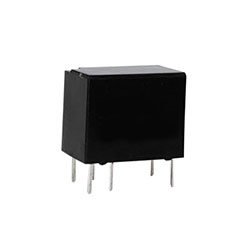Signal Relays Troubleshooting
During the use of signal relays, various malfunctions often occur due to various reasons, such as low product quality, improper use, and poor repair. For electronic relays, as there are currently few types used on locomotives, their faults, handling, inspection, and testing have their own characteristics. Here, ATO industrial automation mainly introduce the faults and handling of contact relays, the most common ones as follows:
Loose and Cracked Contacts
Contacts are the electrical contact parts used by signal relays to switch loads. Some products rely on riveting and pressing to fit the contacts. The main drawbacks are loose contacts, cracked contacts, or excessive deviation in size and position, which will affect the contact reliability of signal relays. The loosening of the removal point is caused by the unreasonable size of the fitting part between the spring and the contact point, or improper adjustment of the riveting pressure by the operator.  Contact cracking is caused by excessive material hardness or pressure. For contacts made of different materials using different material processes, some contact materials with higher hardness should undergo annealing treatment before contact manufacturing, riveting, or spot welding. Contact manufacturing should be careful, as there are tolerances in the material, the length of each cut should be determined after trial testing. The manufacturing of contacts should not show any flash, pad damage, or fullness.
Contact cracking is caused by excessive material hardness or pressure. For contacts made of different materials using different material processes, some contact materials with higher hardness should undergo annealing treatment before contact manufacturing, riveting, or spot welding. Contact manufacturing should be careful, as there are tolerances in the material, the length of each cut should be determined after trial testing. The manufacturing of contacts should not show any flash, pad damage, or fullness.
Contact riveting deviation is caused by the operator's incorrect alignment of the mold and misalignment of the upper and lower touch points. Contact damage, contamination, and uncleaned mold caused by oil contamination and iron filings. Regardless of the problem, it will affect the reliability of the relay's operation. Therefore, during the manufacturing, riveting, or welding process of contacts, it is necessary to comply with the self inspection regulations for intermediate sampling and final inspection during the first article inspection to improve the assembly quality.
Signal Relay Parameters are Unstable
A considerable part of the components of electromagnetic relays are riveted together, and the main problem is that the riveted parts are loose or have poor bonding strength. This kind of problem can make the signal relay parameters unstable, with significant changes in parameters at high and low temperatures, and poor resistance to mechanical vibration and impact. The main reasons for this problem are improper placement of parts, unqualified quality of molds, or inaccurate installation. Therefore, before riveting, it is necessary to carefully inspect whether the tooling and riveted parts meet the requirements.
Deformation of Electromagnetic System Riveting Parts
After riveting, the bending, twisting, and rough and black pier of the parts make it difficult to assemble or adjust in the next process, and may even result in scrapping. The main reasons for this problem are that the riveted parts are too long, too short, or the force is uneven during riveting, the mold assembly deviation or design size is incorrect, and the parts are placed improperly. When riveting, the operator should first check the dimensions, appearance, and accuracy of the components. If the mold is not installed in place, it will affect the assembly quality of the electromagnetic system or the deformation of the iron core or the thickness of the pier.
Damage to Glass Insulators
Glass insulators are made by sintering metal pins with glass. During inspection, assembly, adjustment, transportation, and cleaning, the pins are prone to bending, causing glass insulators to fall off and crack, resulting in air leakage and a decrease in insulation and pressure resistance. Pin rotation can also cause contact spring displacement, affecting the reliable connection and disconnection of the product. This requires the assembly operator to handle the signal relay gently throughout the entire production process, and the components should be neatly arranged in the transfer box. During assembly or adjustment, it is not allowed to pull or twist the leading foots.
Coil Fault
There are various types of coils used in relays, whether they are outsourced or not. The coils should be separated and placed in dedicated equipment. If they collide and are interconnected, they may cause wire breakage when separated. When riveting the electromagnetic system, the pressure adjustment of the hand press and the press should be moderate. Excessive pressure can cause coil breakage, cracking, deformation, and winding breakdown of the coil frame. However, too little pressure can cause loose winding and increased magnetic loss. Multi winding coils generally use leads of different colors as the head. When welding, attention should be paid to distinguishing, otherwise it will cause coil welding errors. Coils with beginning and end requirements are generally marked with markings. Therefore, attention should be paid during assembly and welding, otherwise it may result in opposite signal relay levels.
There are many reasons for signal relay failures. In addition to requiring the manufacturer to ensure product quality, correct use and careful repair are also important links to reduce faults and ensure reliable work.

